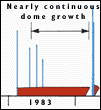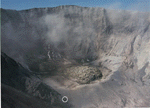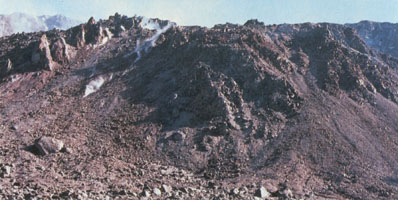 Summary of eruptive activity [41 K]
Summary of eruptive activity [41 K]
Since May 18, 1980, Mount St. Helens has remained intermittently active, and through early 1990 and at least 21 more periods of eruptive activity had occurred. Geologists view these periods of activity as eruptive episodes of one eruption that continued through the decade, rather than separate eruptions. The first of these smaller but significant eruptive episodes began early Sunday morning, May 25, 1980, when Mount St. Helens explosively erupted ash and formed an eruption column that rose to a maximum altitude of 9 miles. At least one pyroclastic flow accompanied the vertical ash emission. Although this eruption was considerably less energetic and voluminous than that of May 18, it nonetheless caused much concern because of memories of the events of the previous Sunday. Variable winds dispersed ash over southwestern Washington and neighboring Oregon, producing small to moderate ash falls in communities that had been spared the ash fall of May 18.
For the next 2 weeks, Mount St. Helens remained relatively quiet, puffing gas but little ash. Meanwhile, rootless steam-blast eruptions continued in the northern periphery of the apron of the pyroclastic flows in the valley of the North Fork of the Toutle River. On clear nights, aerial observers reported seeing glows in the vent within the crater, interpreted to reflect the near-surface presence of very hot rock or magma, although no lava was extruded. On June 12, the volcano again erupted, generating ash falls to the south-southwest and pyroclastic flows down its north flank. The June 12 episode was similar to that on May 25 in style and volume, and both eruptions were preceded by volcanic tremor a few hours in advance.
Probably within hours following the explosive activity on June 12, but hidden by poor visibility, very stiff magma began to ascend in the vent, slowly oozed onto the crater floor, and formed a bulbous lava dome (a mound of sticky lava) about 1,200 feet in diameter and 150 feet high. Such lava domes commonly form at composite volcanoes following major explosive eruptions. The formation what was to be the first of three domes at Mount St. Helens during the 1980s was confirmed by observers on June 15, when visibility over the volcano improved.
Mount St. Helens erupted again in three explosive pulses during the afternoon and evening of July 22. The July eruptive episode was preceded by several days of measurable expansion of the summit area, heightened earthquake activity, and changed emission rates of sulfur dioxide and carbon dioxide. Plumes of ash rose to altitudes of between 6 and 11 miles. The July 22 events destroyed most of the dome formed in mid-June, and pyroclastic flows poured through the north breach of the summit crater and overrode earlier flows of May and June. No dome developed after the end of the explosive activity, which ejected only about one-tenth as much ash as did the May 25 and June 12 explosions.
During the next 3 months, explosive episodes occurred on August 7 and on October 16-18. These events were preceded by differing combinations of the following precursors: increased earthquake activity, volcanic tremor, changed rates of gas emission, and expansion of the crater near the vent. Both episodes produced ash-and-gas clouds and pyroclastic flows. A small dome formed after the August explosions but was blasted away at the start of the October activity.
 Summary of eruptive activity [41 K]
Summary of eruptive activity [41 K]Another dome began to form within 30 minutes after the final explosion on October 18, and within a few days it was about 900 feet wide and 130 feet high. The October 16-18 eruptive episode turned out to be the last major explosive activity at Mount St. Helens during the 1980s. All subsequent eruptive episodes, beginning with the December 27, 1980-January 3, 1981 episode, involved predominantly nonexplosive, dome-building activity that added material to the October dome. During the remainder of 1981, five such dome-building episodes, accompanied by little or no ash ejection, took place: February 5-7, April 10-12, June 18-19, September 6-11, and October 30-November 2.
Three eruptive episodes occurred in 1982: March 19-April 9, May 14-18, and August 18-23. A moderate explosion initiated the March-April episode, ejecting ash 9 miles high and melting snow in the crater that generated a mudflow which eventually entered the North Fork of the Toutle River. Dome growth followed this explosion. The May and August episodes reverted to the nonexplosive style and involved only dome growth. For about a month following the end of the May event, however, small explosions were frequent and at times impressive, producing spectacular vertical plumes of gas and rock debris many thousands of feet high. These were visible from Portland, Oregon (50 miles away) and, on occasion, even from Seattle (100 miles away). More than 500 similar small explosions occurred sporadically until 1986, during times when the dome was not growing. Scientists believe that these small explosions were caused either or both of the following processes: steam-blasts triggered when cold infiltrating rain and snow melt came in contact with the subsurface hott part of the dome and magma conduit, and rapid expansion of gas carried by the magma itself. Many of the explosions occurred in the late spring and early summer, when snow melt is at a maximum.
 First
lava dome [81 K]
First
lava dome [81 K]A year-long episode of eruptive activity began on February 7, 1983. It was preceded by several explosions on February 2-4 that resembled those just described. The largest of the February explosions produced plumes of gas and ash 2 to 4 miles high. These explosions ripped open a gash high on the east flank of the dome, through which lava extruded several days later. The February dome-building activity culminated in the formation of a spine-like protrusion of lava that rose about 100 feet above the summit of the dome. This spine, as did other smaller ones, lasted for only about 2 weeks and then collapsed into a heap of rubble. Slow growth of the dome took place more or less continuously throughout 1983, accompanied at times by small explosions from a crater at the crest of the dome. During this time, the dome grew not only as lava was added to its surface (extrusion) but also as magma entered and inflated the dome as if a water balloon were being filled (intrusion).

A spine-like protrusion of lava rose about 100 feet above the summit of the dome during February 1983 (Photograph by Thomas Casadevall).
The year-long eruptive episode ended in February 1984, but activity resumed on March 29 and lasted until about April 2, producing a small lava lobe on the surface of the dome. More small explosions occurred during the spring and summer months, and on September 10-12 a large lava lobe was extruded, accompanied by major distention of the north part of the dome at unprecedented rates that approached 120 feet per day!


Dramatic dome growth during the 1981-85 period: (Top) Viewed in August 1981 from a camera station at a distance of about 0.5 mile; the dome is about 535 feet high, or nearly as tall as the George Washington Monument. (Bottom) Seen in August 1985 from the same station; the dome has grown considerably wider and another 220 feet higher (Photographs by Lyn Topinka).
Considerable distention also occurred during the next eruptive episode, May 24-June 10, 1985, when the southern third of the dome was pushed more than 300 feet southward by an intrusion, leaving a deep gorge in its wake that stretched across the dome like a "smile" on a golf ball. Only a little lava oozed from the floor of this gorge (called a graben by geologists), but more than 5 million cubic yards of magma entered the dome and remained stored there.
The last two significant eruptive episodes of the 1980s occurred on May 8-13 and October 21-24, 1986. Each episode was similar, producing a large lava lobe and major internal expansion of the dome. Small explosions preceded the activity in May but not in October. These two episodes, as well as those in September 1984 and May 1985, were accompanied by much more intense earthquake activity than was associated with prior dome-building episodes. This change in style of precursory seismicity, together with the changed style of eruptive activity--from mainly extrusion to about equal occurrence of extrusion and intrusion--suggested that the magma had become stiffer and less able to rise easily to the surface than previously. Moreover, the rate of sulfur dioxide release had progressively decreased with time, suggesting that the magma was "running out of gas." Thus, scientists were not surprised that no dome growth took place during the last 3 years of the 1980s. Perhaps the series of eruptive episodes that began in 1980 has ended. However, in late 1989 periods of increased, though still weak, seismicity occurred, and in early December 1989 and early January 1990, at least three very small explosions deposited thin layers of ash in the crater. Perhaps these events either represent a "dying gasp" or are forerunners of continued or heightened eruptive activity. Time will tell.

Scientists making measurements inside Mount St. Helens' crater to monitor the growth of the "composite dome" (Photograph by Lyn Topinka).
The dome at Mount St. Helens is termed a composite dome by scientists, because it represents the net result of many eruptive events, not just one event. The dome-building process may be pictured as the periodic squeezing of an upward-pointing tube of toothpaste or caulking compound. The process is dynamic, involving the upward movement of new material, cracking and pushing aside of old material, sloughing of material from steep surfaces of the dome, and occasional small but violent explosions that blast out pieces of the dome. These processes result in earthquakes and measurable changes in shape of the dome and nearby crater floor; study of the earthquakes and changes in shape enables prediction of the onset of eruptive episodes.
At the start of 1990, the composite dome was about 3,480 feet by 2,820 feet in diameter and rose about 1,150 feet above the low point on the adjacent crater floor. It has a volume of about 97 million cubic yards, less than 3 percent of the volume of the volcano (about 3.5 billion cubic yards) removed during the landslide and lateral blast on May 18, 1980. If the dome resumes growth at its average rate of the 1980s (about 17 million cubic yards per year), it would take nearly a century to fill in the summit crater and more than 200 years to rebuild Mount St. Helens to its pre-1980 size.
![]() Comparisons
With Other Volcanoes
Comparisons
With Other Volcanoes
URL: <https://pubs.usgs.gov/gip/msh/subsequent.html>
Contact: John Watson
Last updated: 06.25.97